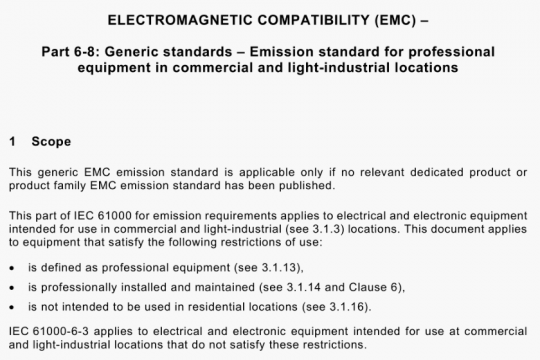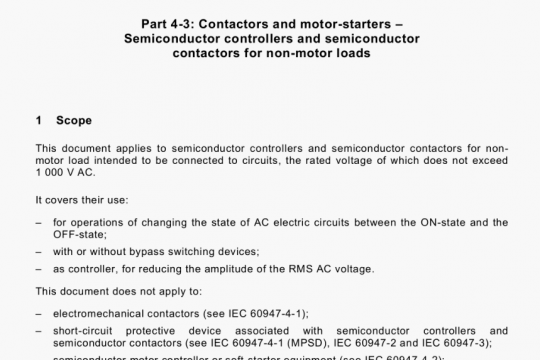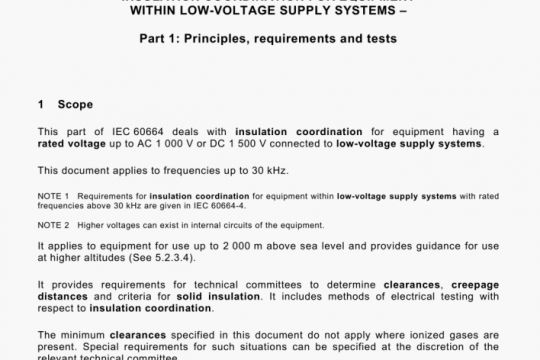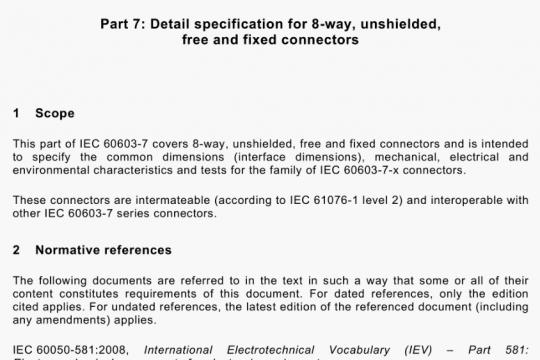IEC 60904-1-2020 pdf free
IEC 60904-1-2020 pdf free.Photovoltaic devices – Part 1: Measurement of photovoltaic current-voltage characteristics.
4 General requirements
4.1 General
For illustration purposes a schematic current-voltage characteristic (I-V curve) is shown in Figure 1 and the corresponding power-voltage characteristic (P-V curve) in Figure 2.
4.2 Measurements
a) When the measurements are intended to be reported at standard test conditions (see 4.5) the in-plane average irradiance during measurement shall be between 800 W’m2 and 1 200 Wm2 to minimise errors arising from large corrections.
b) Temperature sensors should be located so as to detect as closely as possible the temperature of the respective device cell junction. If a temperature gradient between the sensor and the cell junction is suspected, an appropriate contribution to the measurement uncertainty should be included. Consideration should also be given to any possible nonuniformity of temperature across either device, particularly for PV modules, where the temperature of individual cells can vary due to their electrical characteristics, particularly when the module is illuminated under short-circuit conditions. The Equivalent Cell Temperature (ECT) method specified in IEC 60904-5 can be useful in dealing with either a temperature gradient or temperature non-uniformity. The cooling effect from airflow (for example due to wind during outdoor measurement or due to air conditioning of the room for indoor measurements) on the temperature sensors should be considered in the uncertainty of the temperature measurement.
c) The active surface of the device under test shall be coplanar within ±2° with the active surface of the reference device.
d) Voltages and currents shall be measured using independent leads from the terminals of the device under test and keeping them as short as possible. If the device under test is a module, a subassembly or an encapsulated solar cell, the 4-wire connection should start at the terminals or connectors. If the device under test is a bare PV cell, the 4-wire connection should start at the cell bus bars. The connection method for bare cells (i.e. provided without connectors) should be carefully evaluated, Differences can occur if soldered tabs are used compared with non-soldered methods such as bars having contact springs or conductive plates having a large-area contact with the cell back contact. Non-soldered methods can result in higher fill factors than are observed in the module. The contacting method should be appropriate to the intended use of the cell or of the measurement. The contact method used (bare cells) or the contact point (modules) for 4-wire connection shall be stated in the report. For bare solar cells without busbars or cells with low surface conductivity such as multi-busbar cells, 4-wire connection should start at the contacting structure in order to avoid artificially increased fill factors in the measurement caused by voltage drop at the resistance between current and voltage probe on the cell. Possible deviations between the calibration of the measurement system (typically under static load conditions) and its use during 1-V curve measurements (dynamic load conditions) shall be considered.
e) The I-V curve should be measured such that both the short-circuit current point and the open-circuit voltage point fall within the bounds of the data set, including after correction to the reporting conditions (Clause 8). For possible extrapolation to calculate these points from measured data, see Clause 8.
f) The I-V curve can also be measured without illumination (dark I-F) (see Annex C), but this is generally not required.
4.3 Stabilisation
Care shall be taken in measuring PV devices that are metastable. If it is possible to stabilise the device, stabilisation should be performed before any characterisation (I-V or spectral responsivity measurement). Any stabilisation procedure performed shall be reported together with the test results. The IEC 61215 series of standards provides guidance on technology- dependent appropriate stabilisation. In the case of a stabilisation procedure being applied, the device under test should be measured before and after the procedure. The change in 1-V characteristic parameters should be evaluated and included in the report.
If it is not possible to stabilise the device, or stabilisation was not attempted, this shall be indicated in the measurement report.
4.4 Equivalence to steady-state performance
The I-J characteristic for the device under test shall be measured such that it reflects, as closely as possible, the performance of the device under steady-state conditions, i.e. where there is no influence due to drifts in irradiance or device temperature or the voltage sweep rate. Sweep rate effects occur when the voltage bias is stepped or swept too rapidly for the device response to equilibrate for each measurement of the current. This effect can be due to device capacitance, as is the case for some crystalline silicon PV devices, or it can be due to a more complex device response, as is frequently observed in some thin-film devices such as perovskite cells, see IEC TR 63228.IEC 60904-1 pdf download.




